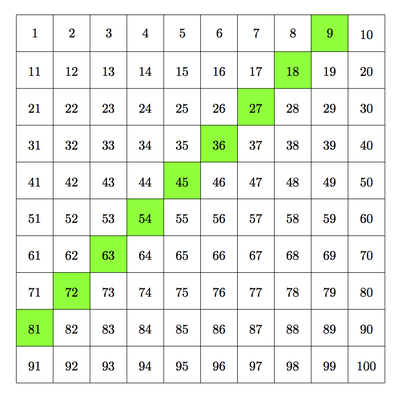What Are Multiples?
Definition of Multiples
Multiples of a number are the products obtained when that number is multiplied by integers. For example, the multiples of 9 are generated by multiplying 9 by the whole numbers (0, 1, 2, 3, etc.). The result is a series of numbers that can be divided evenly by 9, meaning there is no remainder.
How to Calculate Multiples
To find the multiples of 9, you can use either of the following methods:
- Multiplication Method: Multiply 9 by a sequence of integers.
- Repeated Addition Method: Add 9 repeatedly to generate the series of multiples.
Examples of Multiples of 9
The first few multiples of 9 can be calculated as follows:
- Using Multiplication:
- 9×1=9
- 9×2=18
- 9×3=27
- 9×4=36
- 9×5=45
- Using Repeated Addition:
- 9
- 9+9=18
- 18+9=27
- 27+9=36
- 36+9=45
First Ten Multiples of 9
The first ten multiples of 9 are:
- 9
- 18
- 27
- 36
- 45
- 54
- 63
- 72
- 81
- 90
Properties of Multiples of 9
Understanding the properties of multiples of 9 can enhance your mathematical skills. Here are some key properties:
- Divisibility: A number is a multiple of 9 if it can be divided by 9 without leaving a remainder. For example, 72 is a multiple of 9 because 72÷9=8.
- Infinite Multiples: There are infinitely many multiples of 9. As you continue to multiply 9 by larger integers, you will generate larger multiples.
- Pattern in Digits: The digits of the multiples of 9 exhibit interesting patterns:
- The sum of the digits of any multiple of 9 is also a multiple of 9. For example, for 81, 8+1=9, which is a multiple of 9.
- Alternating Patterns: The last digit of the multiples of 9 follows a specific pattern:
- The last digits alternate between 9 and 0 for every ten multiples. For example, the last digits of the first ten multiples are 9, 8, 7, 6, 5, 4, 3, 2, 1, and 0.
- Common Multiples: Multiples of 9 can also be common multiples with other numbers. For example, 18 is a common multiple of both 9 and 6.
Finding Higher Multiples of 9
List of Multiples of 9 Up to 100
Here is a list of the multiples of 9 up to 100:
- 9
- 18
- 27
- 36
- 45
- 54
- 63
- 72
- 81
- 90
- 99
List of Multiples of 9 Up to 200
The multiples of 9 up to 200 are:
- 9
- 18
- 27
- 36
- 45
- 54
- 63
- 72
- 81
- 90
- 99
- 108
- 117
- 126
- 135
- 144
- 153
- 162
- 171
- 180
- 189
- 198
List of Multiples of 9 Up to 1000
The multiples of 9 extend far beyond 200. Here are the first few multiples of 9 up to 1000:
- 9
- 18
- 27
- 36
- 45
- 54
- 63
- 72
- 81
- 90
- 99
- 108
- 117
- 126
- 135
- 144
- 153
- 162
- 171
- 180
- 189
- 198
- 207
- 216
- 225
- 234
- 243
- 252
- 261
- 270
- 279
- 288
- 297
- 306
- 315
- 324
- 333
- 342
- 351
- 360
- 369
- 378
- 387
- 396
- 405
- 414
- 423
- 432
- 441
- 450
- 459
- 468
- 477
- 486
- 495
- 504
- 513
- 522
- 531
- 540
- 549
- 558
- 567
- 576
- 585
- 594
- 603
- 612
- 621
- 630
- 639
- 648
- 657
- 666
- 675
- 684
- 693
- 702
- 711
- 720
- 729
- 738
- 747
- 756
- 765
- 774
- 783
- 792
- 801
- 810
- 819
- 828
- 837
- 846
- 855
- 864
- 873
- 882
- 891
- 900
- 909
- 918
- 927
- 936
- 945
- 954
- 963
- 972
- 981
- 990
- 999
Applications of Multiples of 9
Educational Use
Multiples of 9 are often used in educational settings to teach students about multiplication, division, and number patterns. Understanding multiples can help students with:
- Basic Arithmetic: Multiples of 9 are frequently used in exercises to practice multiplication and division.
- Problem Solving: Recognizing multiples can assist in solving problems involving factors and least common multiples.
Real-World Applications
- Time Management: The concept of multiples is used in scheduling and time management, such as calculating time intervals.
- Financial Calculations: Multiples of 9 can appear in budgeting and financial planning, particularly in scenarios involving group purchases or discounts.
Interesting Facts About Multiples of 9
- Digital Root: The digital root of any multiple of 9 is always 9. For example, for 81, 8+1=9.
- Cultural Significance: In various cultures, the number 9 is considered lucky or significant. For instance, in Chinese culture, the number 9 is associated with long-lasting and eternal love.
- Mathematical Patterns: The multiples of 9 create a unique pattern in the decimal system. For every ten multiples, the last digit cycles through 9, 8, 7, 6, 5, 4, 3, 2, 1, and 0.
Table of Key Information
| Aspect | Details |
|---|---|
| Definition | Numbers that can be divided by 9 without a remainder |
| First 10 Multiples | 9, 18, 27, 36, 45, 54, 63, 72, 81, 90 |
| Properties | Infinite multiples, digit sum divisible by 9 |
| Applications | Education, time management, financial calculations |
| Interesting Fact | The digital root of multiples of 9 is always 9 |
For more information about multiples and their properties, you can refer to the Wikipedia page on multiples: Multiples.
FAQ Section
1. What are the first five multiples of 9?
The first five multiples of 9 are 9, 18, 27, 36, and 45.
2. How do you find the multiples of 9?
You can find the multiples of 9 by multiplying 9 by whole numbers (1, 2, 3, etc.) or by adding 9 repeatedly.
3. Are there infinite multiples of 9?
Yes, there are infinitely many multiples of 9.
4. What is a common multiple of 6 and 9?
The least common multiple of 6 and 9 is 18.
5. How can I tell if a number is a multiple of 9?
A number is a multiple of 9 if it can be divided by 9 without a remainder.
6. What is the significance of the number 9 in different cultures?
In many cultures, the number 9 is considered lucky or significant, often associated with long-lasting relationships and eternal love.
7. How do multiples of 9 relate to digital roots?
The digital root of any multiple of 9 will always equal 9.
8. Can multiples of 9 be used in real-world applications?
Yes, multiples of 9 can be used in various real-world applications, including time management and financial calculations.
9. What patterns do the multiples of 9 follow?
The last digit of the multiples of 9 follows a specific pattern: 9, 8, 7, 6, 5, 4, 3, 2, 1, and 0 for every ten multiples.
10. How many multiples of 9 are there up to 100?
There are 11 multiples of 9 up to 100: 9, 18, 27, 36, 45, 54, 63, 72, 81, 90, and 99.



